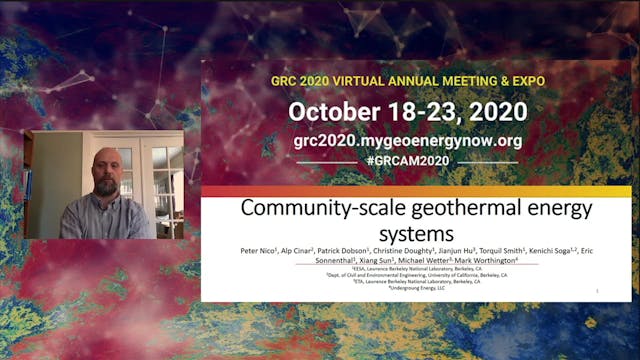Using Saline or Brackish Aquifers as Reservoirs for Thermal Energy Storage
Direct Use
•
9m 37s
Tools to evaluate reservoir thermal energy storage (RTES; heat storage in permeable zones that underlie well-connected regional aquifers) are developed and applied to the Columbia River Basalt Group (CRBG) beneath the Portland Basin, Oregon, USA. The performance of RTES for heat storage and recovery in the Portland Basin is strongly dependent on the operational schedule of heat injection and extraction. RTES is shown to be feasible for heating a large building on the Oregon Health and Science University South Waterfront campus. Initially, the reservoir is heated, and conductive heat loss is high due to high temperature gradients between the reservoir and surrounding rock. The rate of conductive heat loss decreases, and heat recovery efficiency increases over time. Simulations demonstrate the effects of varying heat-injection and extraction. If 100% of building heating needs are supplied by combined solar/RTES, then the solar system must be sized to meet building needs plus long-term conductive losses (i.e., conductive losses once the system reaches pseudo-steady state). If the solar heating system barely meets these criteria, then during early years, less than 100% of the building demand will be supplied until the reservoir is fully-heated. The duration of supplying less than 100% of building demand can be greatly shortened by pre-heating the reservoir or by adding extra heat from external sources during early years. Analytic solutions are developed to evaluate efficacy and to help design RTES systems (e.g., well-spacing, thermal source sizing, etc.). A map of thermal energy storage capacity is produced for the CRBG beneath the Portland Basin. The simulated building has an annual heat load of ~1.9 GWh, and the total annual storage capacity of the Portland Basin is estimated to be 43,400 GWh assuming seasonal storage of heat yields water from which 10 °C can be extracted via heat exchange, indicating a tremendous heating capacity of the CRBG.
Up Next in Direct Use
-
Community-scale Geothermal Energy Sys...
Much of the focus surrounding geothermal energy resource utilization has been on high enthalpy resources for electrical power generation – these systems are typically restricted to regions with high heat flow. However, there exists a much more extensive set of geothermal resources that can be emp...
-
Energy Storage Coupling System of Low...
With the increasingly serious environmental pollution, the utilization of clean resources such as geothermal energy is gradually increasing. Building heating is the main application mode of geothermal energy, but the existing geothermal energy heating system is mainly based on a single mode. Its ...
-
Rapid Geothermal District Heating Ass...
Fourth generation district heating (4GDH) materials technology and methods are making previously uneconomic conventional geothermal resources feasible for district heating development. Numerous low-temperature conventional geothermal resources exist near communities in the Western United States. ...



